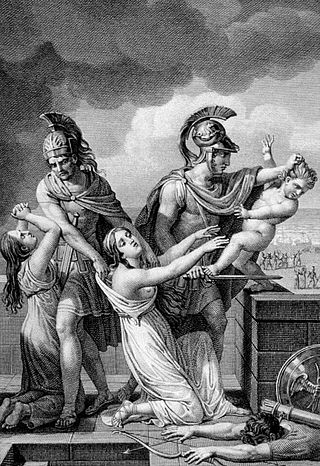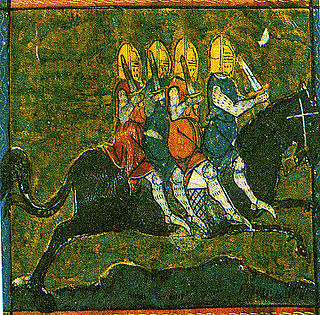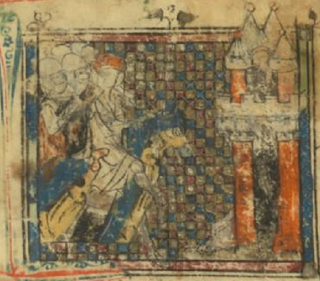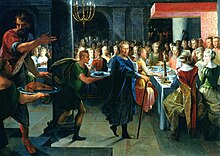
In Greek mythology, Astyanax was the son of Hector, the crown prince of Troy, and his wife, Princess Andromache of Cilician Thebe. His birth name was Scamandrius, but the people of Troy nicknamed him Astyanax, because he was the son of the city's great defender and the heir apparent's firstborn son.

Bayard is a magical bay horse in the legends derived from the medieval chansons de geste. These texts, especially that of The Four Sons of Aymon, attribute to him magical qualities and a supernatural origin. He is known for his strength and intelligence, and possesses the supernatural ability to adjust his size to his riders.

Maugris or Maugis was one of the heroes of the chansons de geste and romances of chivalry and the Matter of France that tell of the legendary court of King Charlemagne. Maugis was cousin to Renaud de Montauban and his brothers, son of Beuves of Aygremont and brother to Vivien de Monbranc. He was brought up by Oriande the fairy, and became a great enchanter. He won the magical horse Bayard and the sword Froberge which he later gave to Renaud.

The Historia Caroli Magni, also known as the Historia Karoli Magni et Rotholandi or the (Pseudo-)Turpin Chronicle, is a 12th-century Latin chronicle consisting of legendary material about Charlemagne's campaigns in Spain. The chronicle states it was written by Charlemagne's contemporary Turpin, Archbishop of Reims, but it was found out as a medieval forgery. The work was extremely popular, and served as a major source of material on Charlemagne in chronicles, fiction and iconography throughout Medieval Europe. The miracles of the flowering lances and the death of Ferracutus appear on the windows of Chartres cathedral.

The Grandes Chroniques de France is a vernacular royal compilation of the history of the Kingdom of France, most manuscripts of which are luxury copies that are heavily illuminated. Copies were produced between the thirteenth and fifteenth centuries, the text being extended at intervals to cover recent events. It was first compiled in the reign of Saint Louis, who wished to preserve the history of the Franks, from the coming of the Trojans to his own time, in an official chronography whose dissemination was tightly controlled. It was continued under his successors until completed in 1461. It covers the Merovingian, Carolingian, and Capetian dynasties of French kings, with illustrations depicting personages and events from virtually all their reigns.

The Châtelaine de Vergy is an anonymous short 13th-century romance of courtly love in Old French.

The Roman d'Alexandre, from the Old French Li romans d'Alixandre, is a 16,000-verse twelfth-century Old French Alexander romance detailing various episodes in the life of Alexander the Great. It is considered by many scholars as the most important of the Medieval Alexander romances. Many of the manuscripts of the work are illustrated. The poem is generally divided into four branches. The final form of the poem is largely credited to Alexander of Paris who probably placed the branches in the order we find them, reworked the first branch into alexandrines, incorporated the text of Pierre de Saint-Cloud, and added verses to join each branch.
Andrea Mangiabotti, called Andrea da Barberino, was an Italian writer and cantastorie ("storyteller") of the Quattrocento Renaissance. He was born in Barberino Val d'Elsa, near Florence, and lived in Florence. He is principally known for his prose romance epic Il Guerrin Meschino, his I Reali di Francia, a prose compilation of the Matter of France epic material concerning Charlemagne and Roland (Orlandino) from various legends and chansons de geste, and for his Aspramonte, a reworking of the chanson de geste Aspremont, which also features the hero Ruggiero. Many of his writings probably derive from Franco-Italian works, such as the Geste Francor, that includes versions of the stories of Reali di Francia and dates to the first half of the fourteenth century. His works, which circulated at first in manuscript, were extremely successful and popular, and were a key source of material for later Italian romance writers, such as Luigi Pulci (Morgante), Matteo Maria Boiardo and Ludovico Ariosto.
Agolant or Agolante is a fictional character in Medieval and Renaissance romantic epics dealing with the Matter of France, including Orlando innamorato by Matteo Maria Boiardo and Orlando furioso by Ludovico Ariosto. He is a Saracen king from Africa.
Chanson d'Aspremont is a 12th-century Old French chanson de geste. The poem comprises 11, 376 verses, grouped into rhymed laisses. The verses are decasyllables mixed with alexandrines.
Bertrand de Bar-sur-Aube was an Old French poet from the Champagne region of France who wrote a number of chansons de geste. He is the author of Girard de Vienne, and it is likely that he also wrote Aymeri de Narbonne. The chansons de gesteNarbonnais and Beuve de Hantone have also been attributed to him, but these attributions are contested. At the beginning of Girart de Vienne, the author describes himself as a "clerc" or cleric. No other biographical information is known about him.
Girart de Vienne is a late twelfth-century (c.1180) Old French chanson de geste by Bertrand de Bar-sur-Aube. The work tells the story of the sons of Garin de Monglane and their battles with the Emperor Charlemagne, and it establishes the friendship of the epic heroes Olivier and Roland.

Aymeri de Narbonne is a legendary hero of Old French chansons de geste and the Matter of France. In the legendary material, as elaborated and expanded in various medieval texts, Aymeri is a knight in the time of Charlemagne's wars with the Saracens after the Battle of Roncevaux Pass. He is son of Hernaut and the grandson of Garin de Monglane. He conquers the city of Narbonne, marries a princess named Hermengarde or Hermenjart, and fathers seven sons, the most famous being Guillaume d'Orange, the hero of several popular chansons de geste.
The Chanson de Guillaume, also called Chançun de Willame, is a chanson de geste from the first half of the twelfth-century. The work is generally considered to have two distinct halves: the first tells of Guillaume of Orange, his nephew Vivien and the latter's young brother Gui and their various battles with Saracens at L'Archamp; in the second half of the poem, Guillaume is aided by Rainouard, a giant.
The Charroi de Nîmes, is an Old French chanson de geste from the first half of the twelfth-century, part of the cycle of chansons concerning Guillaume of Orange, generally referred to collectively as the Geste de Guillaume d'Orange.

Galiens li Restorés, or Galien le Restoré or Galien rhétoré, is an Old French chanson de geste which borrows heavily from chivalric romance. Its composition dates anywhere from the end of the twelfth century to the middle of the fourteenth century. Five versions of the tale are extant, dating from the fifteenth century to the sixteenth century, one in verse and the others in prose. The story—which is closely linked to the earlier chansons de gestePèlerinage de Charlemagne and The Song of Roland —tells of the adventures of Galien, son of the hero Olivier and of Jacqueline, the daughter of the (fictional) emperor Hugon of Constantinople.
Gormond et Isembart is an Old French chanson de geste from the second half of the eleventh or first half of the twelfth century. Along with The Song of Roland and the Chanson de Guillaume, it is one of the three chansons de geste whose composition incontestably dates from before 1150; it may be slightly younger than The Song of Roland and, according to one expert, may date from as early as 1068. The poem tells the story of a rebellious young French lord, Isembart, who allies himself with a Saracen king, Gormond, renounces his Christianity, and battles the French king. The poem is sometimes grouped with the Geste de Doon de Mayence or "rebellious vassal cycle" of chansons de geste.
Jean Bagnyon or Jehan Bagnyon was a lawyer, historian, political writer, and translator born in 1412, in Croy, in the canton of Vaud, which was, at that time, a part of the Duchy of Savoy. He died sometime after 1487.
Geneviève Hasenohr is a French philologist and prolific scholar of medieval and Renaissance French literature. She has authored or contributed to more than forty books, written at least fifty academic articles and reviews, and prepared numerous scholarly editions.

Michel Zink is a French writer, medievalist, philologist, and professor of French literature, particularly that of the Middle Ages. He is the Permanent Secretary of the Académie des Inscriptions et Belles-Lettres, a title he has held since 2011, and was elected to the Académie française in 2017. In addition to his academic work, he has also written historical crime novels, one of which continues the story of Arsène Lupin.










